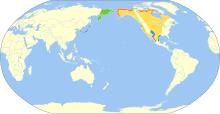Cackling goose
| Cackling goose | |
|---|---|

| |
| Aleutian cackling goose | |
| Scientific classification | |
| Domain: | Eukaryota |
| Kingdom: | Animalia |
| Phylum: | Chordata |
| Class: | Aves |
| Order: | Anseriformes |
| Family: | Anatidae |
| Genus: | Branta |
| Species: | B. hutchinsii
|
| Binomial name | |
| Branta hutchinsii (Richardson, 1832)
| |
| Subspecies | |
| |

| |
| Synonyms | |
|
Branta canadensis hutchinsii | |
The cackling goose (Branta hutchinsii) is a species of goose found in North America and East Asia.
Systematics
The genus name Branta is a Latinised form of Old Norse Brandgás, "burnt (black) goose", and the specific epithet hutchinsii commemorates English surgeon Thomas Hutchins who was employed by the Hudson's Bay Company.[2]
The cackling goose was originally considered to be the same species or a subspecies of the
The AOU has divided the many associated subspecies between both animals. To the present species were assigned:
- Richardson's cackling goose (B. h. hutchinsii)
- Aleutian cackling goose (B. h. leucopareia)
- Small cackling goose (B. h. minima)
- Taverner's cackling goose (B. h. taverneri)
- †extinct(c.1929)
The distinctions between the two geese have led to a great deal of confusion and debate among ornithologists. This has been aggravated by the overlap between the small types of Canada goose and larger types of cackling goose. The old "lesser Canada geese" were believed to be a partly
In the wake of the discussion generated by the official standalone species designation, introduced by the AOU and BOU in 2004 and 2005, Harold C. Hanson published a paper in 2007 suggesting that Canada and cackling geese should be split into six species and 200 subspecies. The radical nature of this proposal provoked surprise, with Richard Banks of the AOU urging caution before any of Hanson's proposals be accepted.[3] No further redesignation has been introduced by either of these Ornithologists' Unions.
Description
The black head and neck with white "chinstrap" distinguish this goose from all other geese except the larger
Measurements:[4]
- Length: 24.8–25.6 in (63–65 cm)
- Weight: 49.3–84.0 oz (1,400–2,380 g)
- Wingspan: 42.5–43.7 in (108–111 cm)

Range
This species is native to North America. It breeds in northern Canada and Alaska in a variety of tundra habitats. However, the nest is usually located in an elevated area near water. The eggs are laid in a shallow depression lined with plant material and down. Males can be very aggressive in defending territory. A pair may mate for life (up to around 20 years). Adult geese are often seen leading their goslings in a line with one parent at the front, and the other at the back of the "parade".
Like most geese, it is naturally migratory, the wintering range being most of the U.S., and locally in western Canada and northern Mexico. The calls overhead from large groups of cackling geese flying in V-shaped formation signal the transitions into spring and fall. In some areas, migration routes have changed due to changes in habitat and food sources.
Cackling geese have occasionally reached western
Feeding
These birds feed mainly on plant material. When feeding in water, they submerge their heads and necks to reach aquatic plants, sometimes tipping forward like a
Status
By the early 20th century, over-hunting and loss of habitat in the late 19th and early 20th centuries had resulted in a serious decline in the numbers of this bird in its native range. With improved game laws and habitat restoration and preservation programs, their populations have recovered in most of their range, although some local populations may still be declining, especially of the subspecies minima and leucopareia. Though the taxonomic distinctness of the Komandorski and Kuril Islands populations, which used to winter in Japan, is controversial, it is without doubt that they disappeared around 1929.

References
- ^ . Retrieved 11 November 2021.
- ISBN 978-1-4081-2501-4.
- ^ Banks, Richard (2007) Review of Harold Hanson's "The White-Cheeked Geese: Branta Canadensis, B. Maxima, B. ‘‘Lawrensis’’, B. Hutchinsii, B. Leucopareia, And B. Minima. Taxonomy, Ecophysiographic Relationships, Biogeography, And Evolutionary Considerations. Volume 1. Eastern Taxa" The Wilson Journal of Ornithology
- ^ "Cackling Goose Identification, All About Birds, Cornell Lab of Ornithology". www.allaboutbirds.org. Retrieved 2020-09-25.
Further reading
- Stackhouse, Mark. The New Goose.
- Angus, Wilson. Identification and range of subspecies within the Canada and Cackling Goose Complex (Branta canadensis & B. hutchinsii).
- Moser, Timothy J., Craven, Scott R. and Miller, Brian K. Canada Geese in the Mississippi Flyway: A Guide for Goose Hunters and Goose Watchers.
- Martin Garner Focus On: 'white-cheeked' geese.
External links
- Cackling Goose photo gallery at VIREO (Drexel University)
- Cackling Goose – Cornell Lab of Ornithology

